Ying Zhang
Sid
Closing the Loop: Coordinating Inventory and Recommendation via Deep Reinforcement Learning on Multiple Timescales
Oct 05, 2025Abstract:Effective cross-functional coordination is essential for enhancing firm-wide profitability, particularly in the face of growing organizational complexity and scale. Recent advances in artificial intelligence, especially in reinforcement learning (RL), offer promising avenues to address this fundamental challenge. This paper proposes a unified multi-agent RL framework tailored for joint optimization across distinct functional modules, exemplified via coordinating inventory replenishment and personalized product recommendation. We first develop an integrated theoretical model to capture the intricate interplay between these functions and derive analytical benchmarks that characterize optimal coordination. The analysis reveals synchronized adjustment patterns across products and over time, highlighting the importance of coordinated decision-making. Leveraging these insights, we design a novel multi-timescale multi-agent RL architecture that decomposes policy components according to departmental functions and assigns distinct learning speeds based on task complexity and responsiveness. Our model-free multi-agent design improves scalability and deployment flexibility, while multi-timescale updates enhance convergence stability and adaptability across heterogeneous decisions. We further establish the asymptotic convergence of the proposed algorithm. Extensive simulation experiments demonstrate that the proposed approach significantly improves profitability relative to siloed decision-making frameworks, while the behaviors of the trained RL agents align closely with the managerial insights from our theoretical model. Taken together, this work provides a scalable, interpretable RL-based solution to enable effective cross-functional coordination in complex business settings.
DHG-Bench: A Comprehensive Benchmark on Deep Hypergraph Learning
Aug 17, 2025Abstract:Although conventional deep graph models have achieved great success in relational learning, their focus on pairwise relationships limits their capacity to learn pervasive higher-order interactions in real-world complex systems, which can be naturally modeled as hypergraphs. To tackle this, hypergraph neural networks (HNNs), the dominant approach in deep hypergraph learning (DHGL), has garnered substantial attention in recent years. Despite the proposal of numerous HNN methods, there is no comprehensive benchmark for HNNs, which creates a great obstacle to understanding the progress of DHGL in several aspects: (i) insufficient coverage of datasets, algorithms, and tasks; (ii) a narrow evaluation of algorithm performance; and (iii) inconsistent dataset usage, preprocessing, and experimental setups that hinder comparability. To fill the gap, we introduce DHG-Bench, the first comprehensive benchmark for DHGL. Specifically, DHG-Bench integrates 20 diverse datasets spanning node-, edge-, and graph-level tasks, along with 16 state-of-the-art HNN algorithms, under consistent data processing and experimental protocols. Our benchmark systematically investigates the characteristics of HNNs in terms of four dimensions: effectiveness, efficiency, robustness, and fairness. Further, to facilitate reproducible research, we have developed an easy-to-use library for training and evaluating different HNN methods. Extensive experiments conducted with DHG-Bench reveal both the strengths and inherent limitations of existing algorithms, offering valuable insights and directions for future research. The code is publicly available at: https://github.com/Coco-Hut/DHG-Bench.
GLM-4.5: Agentic, Reasoning, and Coding (ARC) Foundation Models
Aug 08, 2025Abstract:We present GLM-4.5, an open-source Mixture-of-Experts (MoE) large language model with 355B total parameters and 32B activated parameters, featuring a hybrid reasoning method that supports both thinking and direct response modes. Through multi-stage training on 23T tokens and comprehensive post-training with expert model iteration and reinforcement learning, GLM-4.5 achieves strong performance across agentic, reasoning, and coding (ARC) tasks, scoring 70.1% on TAU-Bench, 91.0% on AIME 24, and 64.2% on SWE-bench Verified. With much fewer parameters than several competitors, GLM-4.5 ranks 3rd overall among all evaluated models and 2nd on agentic benchmarks. We release both GLM-4.5 (355B parameters) and a compact version, GLM-4.5-Air (106B parameters), to advance research in reasoning and agentic AI systems. Code, models, and more information are available at https://github.com/zai-org/GLM-4.5.
WeTok: Powerful Discrete Tokenization for High-Fidelity Visual Reconstruction
Aug 07, 2025Abstract:Visual tokenizer is a critical component for vision generation. However, the existing tokenizers often face unsatisfactory trade-off between compression ratios and reconstruction fidelity. To fill this gap, we introduce a powerful and concise WeTok tokenizer, which surpasses the previous leading tokenizers via two core innovations. (1) Group-wise lookup-free Quantization (GQ). We partition the latent features into groups, and perform lookup-free quantization for each group. As a result, GQ can efficiently overcome memory and computation limitations of prior tokenizers, while achieving a reconstruction breakthrough with more scalable codebooks. (2) Generative Decoding (GD). Different from prior tokenizers, we introduce a generative decoder with a prior of extra noise variable. In this case, GD can probabilistically model the distribution of visual data conditioned on discrete tokens, allowing WeTok to reconstruct visual details, especially at high compression ratios. Extensive experiments on mainstream benchmarks show superior performance of our WeTok. On the ImageNet 50k validation set, WeTok achieves a record-low zero-shot rFID (WeTok: 0.12 vs. FLUX-VAE: 0.18 vs. SD-VAE 3.5: 0.19). Furthermore, our highest compression model achieves a zero-shot rFID of 3.49 with a compression ratio of 768, outperforming Cosmos (384) 4.57 which has only 50% compression rate of ours. Code and models are available: https://github.com/zhuangshaobin/WeTok.
Mesh based segmentation for automated margin line generation on incisors receiving crown treatment
Jul 30, 2025



Abstract:Dental crowns are essential dental treatments for restoring damaged or missing teeth of patients. Recent design approaches of dental crowns are carried out using commercial dental design software. Once a scan of a preparation is uploaded to the software, a dental technician needs to manually define a precise margin line on the preparation surface, which constitutes a non-repeatable and inconsistent procedure. This work proposes a new framework to determine margin lines automatically and accurately using deep learning. A dataset of incisor teeth was provided by a collaborating dental laboratory to train a deep learning segmentation model. A mesh-based neural network was modified by changing its input channels and used to segment the prepared tooth into two regions such that the margin line is contained within the boundary faces separating the two regions. Next, k-fold cross-validation was used to train 5 models, and a voting classifier technique was used to combine their results to enhance the segmentation. After that, boundary smoothing and optimization using the graph cut method were applied to refine the segmentation results. Then, boundary faces separating the two regions were selected to represent the margin line faces. A spline was approximated to best fit the centers of the boundary faces to predict the margin line. Our results show that an ensemble model combined with maximum probability predicted the highest number of successful test cases (7 out of 13) based on a maximum distance threshold of 200 m (representing human error) between the predicted and ground truth point clouds. It was also demonstrated that the better the quality of the preparation, the smaller the divergence between the predicted and ground truth margin lines (Spearman's rank correlation coefficient of -0.683). We provide the train and test datasets for the community.
Regularizing Subspace Redundancy of Low-Rank Adaptation
Jul 28, 2025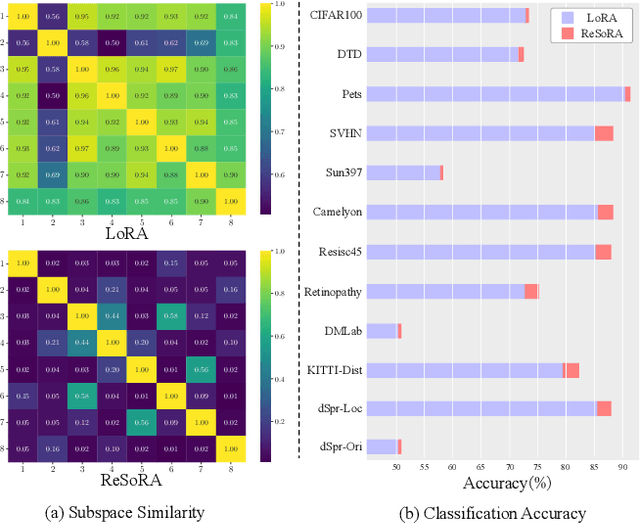

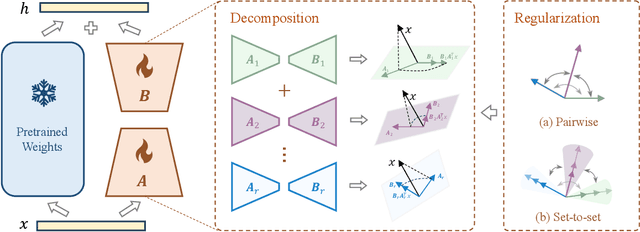
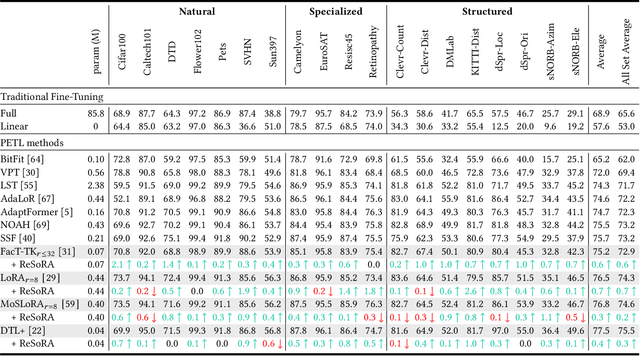
Abstract:Low-Rank Adaptation (LoRA) and its variants have delivered strong capability in Parameter-Efficient Transfer Learning (PETL) by minimizing trainable parameters and benefiting from reparameterization. However, their projection matrices remain unrestricted during training, causing high representation redundancy and diminishing the effectiveness of feature adaptation in the resulting subspaces. While existing methods mitigate this by manually adjusting the rank or implicitly applying channel-wise masks, they lack flexibility and generalize poorly across various datasets and architectures. Hence, we propose ReSoRA, a method that explicitly models redundancy between mapping subspaces and adaptively Regularizes Subspace redundancy of Low-Rank Adaptation. Specifically, it theoretically decomposes the low-rank submatrices into multiple equivalent subspaces and systematically applies de-redundancy constraints to the feature distributions across different projections. Extensive experiments validate that our proposed method consistently facilitates existing state-of-the-art PETL methods across various backbones and datasets in vision-language retrieval and standard visual classification benchmarks. Besides, as a training supervision, ReSoRA can be seamlessly integrated into existing approaches in a plug-and-play manner, with no additional inference costs. Code is publicly available at: https://github.com/Lucenova/ReSoRA.
Quantize More, Lose Less: Autoregressive Generation from Residually Quantized Speech Representations
Jul 16, 2025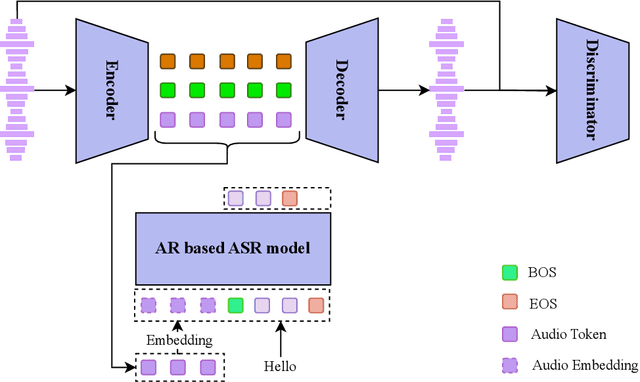



Abstract:Text-to-speech (TTS) synthesis has seen renewed progress under the discrete modeling paradigm. Existing autoregressive approaches often rely on single-codebook representations, which suffer from significant information loss. Even with post-hoc refinement techniques such as flow matching, these methods fail to recover fine-grained details (e.g., prosodic nuances, speaker-specific timbres), especially in challenging scenarios like singing voice or music synthesis. We propose QTTS, a novel TTS framework built upon our new audio codec, QDAC. The core innovation of QDAC lies in its end-to-end training of an ASR-based auto-regressive network with a GAN, which achieves superior semantic feature disentanglement for scalable, near-lossless compression. QTTS models these discrete codes using two innovative strategies: the Hierarchical Parallel architecture, which uses a dual-AR structure to model inter-codebook dependencies for higher-quality synthesis, and the Delay Multihead approach, which employs parallelized prediction with a fixed delay to accelerate inference speed. Our experiments demonstrate that the proposed framework achieves higher synthesis quality and better preserves expressive content compared to baseline. This suggests that scaling up compression via multi-codebook modeling is a promising direction for high-fidelity, general-purpose speech and audio generation.
WIP: Large Language Model-Enhanced Smart Tutor for Undergraduate Circuit Analysis
Jun 10, 2025Abstract:This research-to-practice work-in-progress (WIP) paper presents an AI-enabled smart tutor designed to provide homework assessment and feedback for students in an undergraduate circuit analysis course. We detail the tutor's design philosophy and core components, including open-ended question answering and homework feedback generation. The prompts are carefully crafted to optimize responses across different problems. The smart tutor was deployed on the Microsoft Azure platform and is currently in use in an undergraduate circuit analysis course at the School of Electrical and Computer Engineering in a large, public, research-intensive institution in the Southeastern United States. Beyond offering personalized instruction and feedback, the tutor collects student interaction data, which is summarized and shared with the course instructor. To evaluate its effectiveness, we collected student feedback, with 90.9% of responses indicating satisfaction with the tutor. Additionally, we analyze a subset of collected data on preliminary circuit analysis topics to assess tutor usage frequency for each problem and identify frequently asked questions. These insights help instructors gain real-time awareness of student difficulties, enabling more targeted classroom instruction. In future work, we will release a full analysis once the complete dataset is available after the Spring 2025 semester. We also explore the potential applications of this smart tutor across a broader range of engineering disciplines by developing improved prompts, diagram-recognition methods, and database management strategies, which remain ongoing areas of research.
kTULA: A Langevin sampling algorithm with improved KL bounds under super-linear log-gradients
Jun 05, 2025Abstract:Motivated by applications in deep learning, where the global Lipschitz continuity condition is often not satisfied, we examine the problem of sampling from distributions with super-linearly growing log-gradients. We propose a novel tamed Langevin dynamics-based algorithm, called kTULA, to solve the aforementioned sampling problem, and provide a theoretical guarantee for its performance. More precisely, we establish a non-asymptotic convergence bound in Kullback-Leibler (KL) divergence with the best-known rate of convergence equal to $2-\overline{\epsilon}$, $\overline{\epsilon}>0$, which significantly improves relevant results in existing literature. This enables us to obtain an improved non-asymptotic error bound in Wasserstein-2 distance, which can be used to further derive a non-asymptotic guarantee for kTULA to solve the associated optimization problems. To illustrate the applicability of kTULA, we apply the proposed algorithm to the problem of sampling from a high-dimensional double-well potential distribution and to an optimization problem involving a neural network. We show that our main results can be used to provide theoretical guarantees for the performance of kTULA.
Diversity of Transformer Layers: One Aspect of Parameter Scaling Laws
May 29, 2025


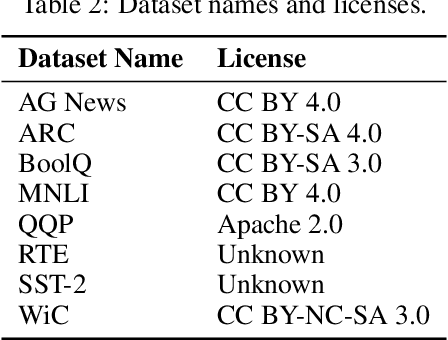
Abstract:Transformers deliver outstanding performance across a wide range of tasks and are now a dominant backbone architecture for large language models (LLMs). Their task-solving performance is improved by increasing parameter size, as shown in the recent studies on parameter scaling laws. Although recent mechanistic-interpretability studies have deepened our understanding of the internal behavior of Transformers by analyzing their residual stream, the relationship between these internal mechanisms and the parameter scaling laws remains unclear. To bridge this gap, we focus on layers and their size, which mainly decide the parameter size of Transformers. For this purpose, we first theoretically investigate the layers within the residual stream through a bias-diversity decomposition. The decomposition separates (i) bias, the error of each layer's output from the ground truth, and (ii) diversity, which indicates how much the outputs of each layer differ from each other. Analyzing Transformers under this theory reveals that performance improves when individual layers make predictions close to the correct answer and remain mutually diverse. We show that diversity becomes especially critical when individual layers' outputs are far from the ground truth. Finally, we introduce an information-theoretic diversity and show our main findings that adding layers enhances performance only when those layers behave differently, i.e., are diverse. We also reveal the performance gains from increasing the number of layers exhibit submodularity: marginal improvements diminish as additional layers increase, mirroring the logarithmic convergence predicted by the parameter scaling laws. Experiments on multiple semantic-understanding tasks with various LLMs empirically confirm the theoretical properties derived in this study.
 Add to Chrome
Add to Chrome Add to Firefox
Add to Firefox Add to Edge
Add to Edge